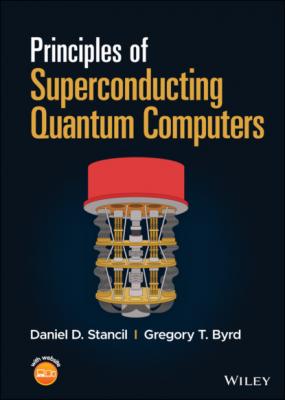Principles of Superconducting Quantum Computers. Daniel D. Stancil
Чтение книги онлайн.
Читать онлайн книгу Principles of Superconducting Quantum Computers - Daniel D. Stancil страница 13
 symblom 1 mathematical right-angle circled-times Math bar pipe bar symblom 0 mathematical right-angle equals Start 3 By 1 Matrix 1st Row 0 times StartBinomialOrMatrix 1 Choose 0 EndBinomialOrMatrix 2nd Row Blank 3rd Row 1 times StartBinomialOrMatrix 1 Choose 0 EndBinomialOrMatrix EndMatrix equals Start 4 By 1 Matrix 1st Row 0 2nd Row 0 3rd Row 1 4th Row 0 EndMatrix comma"/> (1.35)
symblom 1 mathematical right-angle circled-times Math bar pipe bar symblom 0 mathematical right-angle equals Start 3 By 1 Matrix 1st Row 0 times StartBinomialOrMatrix 1 Choose 0 EndBinomialOrMatrix 2nd Row Blank 3rd Row 1 times StartBinomialOrMatrix 1 Choose 0 EndBinomialOrMatrix EndMatrix equals Start 4 By 1 Matrix 1st Row 0 2nd Row 0 3rd Row 1 4th Row 0 EndMatrix comma"/> (1.35)
Any two-qubit state can be written as a linear combination of the basis states:
Two-qubit state vectors are also normalized:
As we will see later, while every two-qubit state can be written in the form of Eq. (1.37), not every two-qubit state can be written as the tensor product of single-qubit states.
This can be generalized into a system with n qubits, requiring state vectors with 2n components with 2n complex coefficients.
1.5.2 Matrix Representation of Two-Qubit Gates
Just as single qubit gates can be represented by 2×2 matrices, an n-qubit gate can be represented by a 2n×2n matrix. Consequently two-qubit gates require the construction of 4×4 unitary matrices. Given two single-qubit operators A and B, the tensor product is defined as:
which creates a 4×4 matrix.
Suppose we wanted to construct a two-qubit circuit starting in the state |10⟩ with an X gate applied to the left qubit, and a Y gate applied to the other. Mathematically this would be written
Referring to (1.24) we see that the X gate will simply flip the left qubit, and referring to (1.25) we see that the Y gate will flip the right qubit and add the coefficient i. We conclude that
To see how this would be implemented using the matrix representation, we first construct the X⊗Y matrix:
Completing the calculation gives the expected result:
A particularly interesting two-qubit circuit is formed by applying a Hadamard gate to each qubit in the ground state: H ⊗ H|00⟩. Let us first compute H ⊗ H:
Completing the calculation gives: